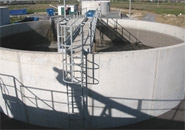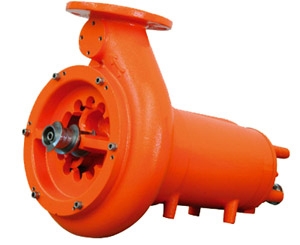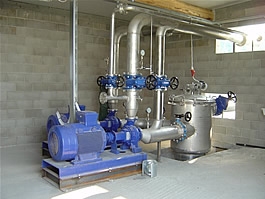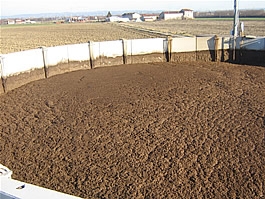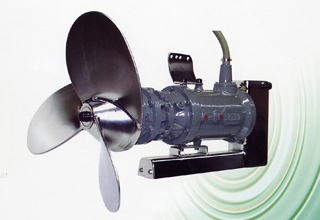Nitro / de-nitro
An effective treatment for the nitrogen reduction in the zootechnic liquid waste as such or after anaerobic digestion, it is certainly the biological process of nitrification – denitrification, which can assure a reduction of the contamination charge up to 70-80%. The biological process is activated by "aeration – forced oxidation" which metabolize the organic contamination charge (COD), transforms the organic nitrogen and the urea in ammonia, then to nitrite and nitrates. The quantity of oxygen given to the treatment tank/tanks, is, alternately, reduced to zero for a fixed time and for prearranged intervals in order to convert the nitrates in elementary nitrogen, in a environment without oxygen (denitrification).
Thanks to the high transfert power of the oxygen, to the natural selection of the specific biomass with high efficiency and to the physic action of "cracking" of the contamination macromolecules, the available technologies can easily treat the various types of manure as such, or from the anaerobic digestors, without using chemical and biological additives and without any production of biological recovery muds, which leads to a costs' reduction and to a more simple management.
BLOCK DIAGRAM: Solution with a treatment tank:
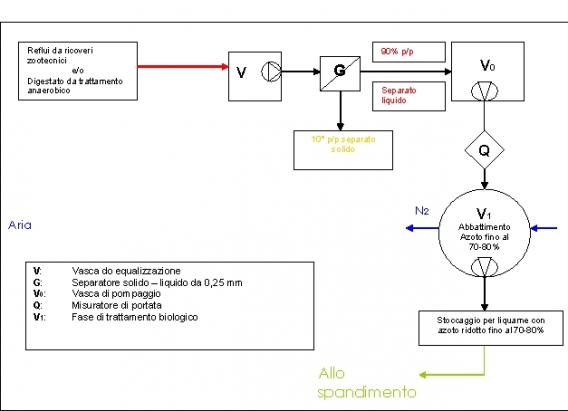
BLOCK DIAGRAM: Solution with two treatment tanks:
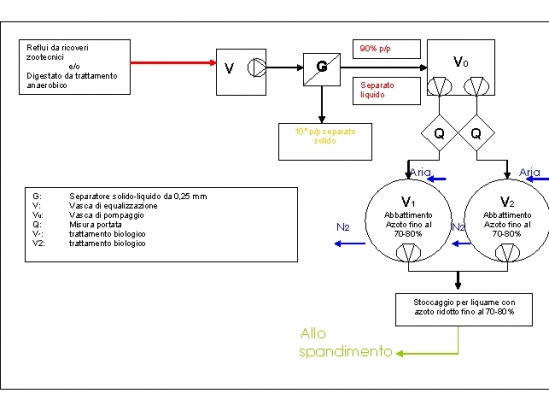
Stabilization tank (V)
The stabilization tank collects the manure from the stable as such, or it recept the mixing manure – digestate (respectively with ratio 90 ÷ 85 % and 10 ÷ 15 v/v).
The tank is equipe with a mixing system and pumping station for the loading of the separation system.

Separation system (G)
The separator with helical compression with screen from 0,25 ÷ 0,50 mm, provides the separatjion of the solid fraction from the liquid part before being passed to the next stage of biological treatment.
The solid part which has been separated, with percentages of dry matter between 25% and 35%, is collected in the platform before its transfert to the fertilization treatment of directly to the soils.
The liquid part is transferred in the collection tank (V0) which acts as a lung, so that the pumps, controller by capacity regulators, can constantly and uniformly load one or more of the next treatment tanks.
Tank (V1-2)
In the tanks V1-2 the nitrogen reduction is reached biologically up to 70-80 % of the nitrogen contained in the liquid manure. Each tank is equipped with a pipeline net installed on the bottom made in AISI 304 and provided with enough "patented" oxygenation devices connected to the atmosphere or to a system of forced aeration. The net is powered by a pump with a special mechanical self-cleaning filter, so to reach the necessary pressure for the development of the "Venturi" effect inside the oxygenation devices.
The process, after a first start stage, operates continously, keeping its performances constant all the time. It means that every day it loads new liquid manure to be treated and the treated matter is then drained and conveyed to special pumps for the storage.
This process of microbioflottation can grant a high nitrogen reduction, and almost sets to zero the NH3 emissions and completely eliminates odours.
Reduction of nitrogen from zootechnic detection by Nitro-Denitro process Nitro-Denitro
Advantages of the system
- Reduction of the nitrogen load in liquid dejections up to 70 – 80 %
- Simple and automatized management with no use of chemical products and without mud production
- Stabilization with complete reduction of odours and of NH3 and CH4 emissions e CH4) from the stored liquid matter
- Proportional reduction of soils necessary for the agricultural distribution
- Possible increasing of the number of animals breeded in the farm with the same soil surface
- General reduction of the environmental effect due to the breeding
- Reduction of management's and distribution's costs
